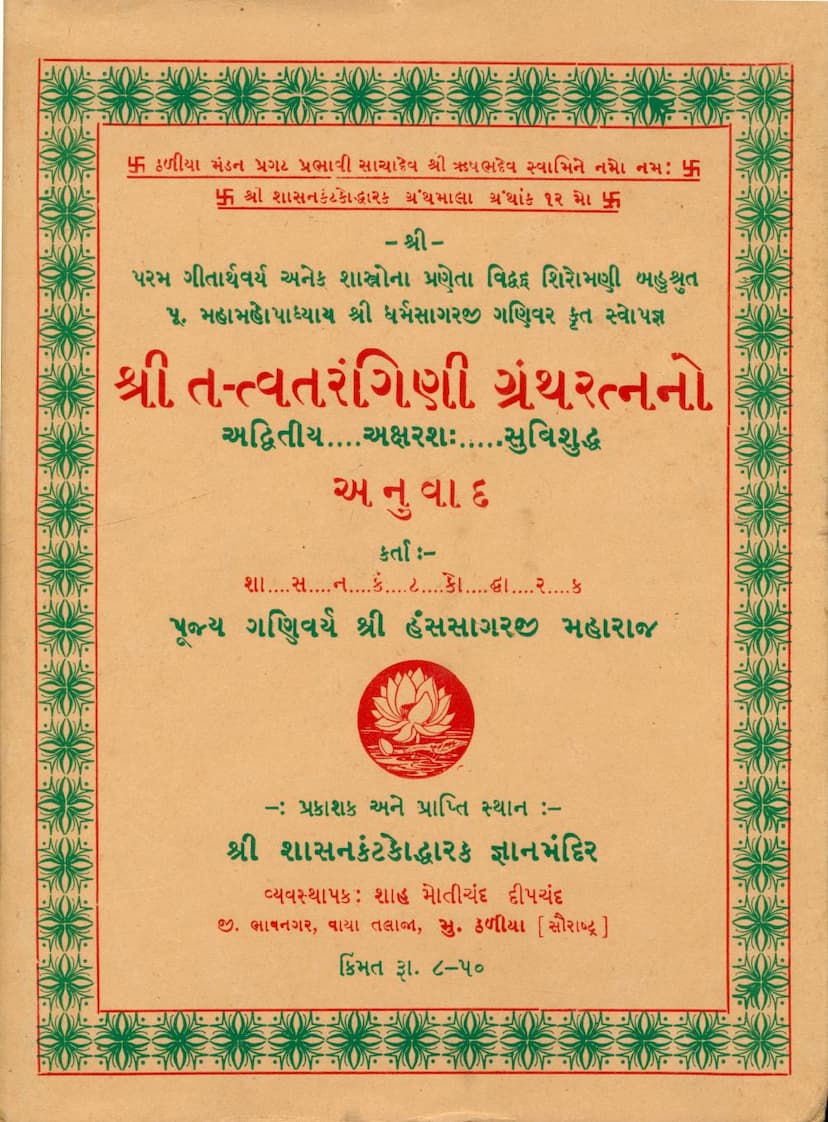Tattva Tarangini Anuwad
Added to library: September 2, 2025

Summary
This Jain text, "Tattva Tarangini Anuwad" by Dharmsagar, published by Shasankantakoddharak Gyanmandir, is a translation and commentary on the original Sanskrit work "Tattva Tarangini." The book serves as a defense and clarification of Jain principles, particularly concerning the determination of auspicious dates (tithi) for religious observances, a topic that had seen considerable debate and differing interpretations within Jain traditions.
Here's a breakdown of the key aspects covered in the text:
1. Introduction and Dedication:
- The book begins with a dedication to the divine Lord Rishabhdev and then to the revered spiritual leaders who inspired and facilitated the translation.
- It highlights the immense contribution of Mahamahopadhyaya Shri Dharmsagarji Ganivar as the author of the original "Tattva Tarangini," praising his profound scholarship and his role in preserving and printing numerous Jain Agamas and commentaries.
- The text also pays tribute to Acharya Shri Anandasagarsurishwarji Maharaj, who is credited with the initial research and discovery of the original texts, and to Acharya Shri Chandrasagarsurishwarji Maharaj for his spiritual guidance.
- A significant portion of the introduction is dedicated to Guruverya Shri Hanssagarji Maharaj, the translator and commentator, acknowledging his diligent three-year effort in producing this accurate and profound translation.
2. Core Subject Matter - Tithi (Auspicious Dates):
- The central theme of "Tattva Tarangini Anuwad" revolves around the correct determination of auspicious dates for Jain festivals and observances, particularly addressing the complexities arising from the lunar calendar's variations (tithi kshaya-vruddhi - the thinning or expansion of dates).
- The text delves into the historical context of how Jain calendars (Panchangs) were traditionally derived from Jain astrological texts. However, due to the loss of some parts of these texts, there arose a reliance on secular (Laukik) Panchangs.
- A significant portion of the text is dedicated to explaining the Jain approach to reconciling Laukik Panchangs with the Agamas. It clarifies that Jain observances are based on a 60-Ghati (approximately 24-hour) period, starting from sunrise.
- The text meticulously explains the principles of Kshaya (loss of a tithi) and Vruddhi (gain of a tithi) in relation to Jain observances. It emphasizes the application of specific Jain rules (Apavaad Sutras) to correctly determine the tithi for worship, even when the Laukik Panchang might indicate otherwise.
- A substantial part of the book is dedicated to refuting "new opinions" (Navamat) that deviate from the established Jain traditions and interpretations regarding tithi determination. The text identifies and critiques various points raised by dissenting schools of thought, particularly those associated with the Kharatar sect, and defends the practices of the Tapa Gachha and Devsuri Tapa Gachha traditions.
3. Key Concepts and Arguments:
- Agam vs. Parampa: The text highlights the importance of Parampara (tradition) in Jain practice, especially in the absence of complete original Agamas. It argues that a tradition established by revered Acharyas, which aligns with the spirit of the Agamas, holds significant weight.
- Tithi Calculation Rules: The text explains specific Jain rules like Kshaya (when a tithi is shorter or absent) and Vruddhi (when a tithi is longer or appears twice). It elaborates on how to handle these situations based on the Agamas and the interpretations of revered Acharyas.
- Debate on Tithi Determination: The book addresses specific points of contention, such as the determination of dates for Upavas (fasting), Chaturmas (four-month rainy season retreat), Samvatsari (annual repentance day), and other important festivals. It systematically refutes the "new opinions" by citing scriptural references, historical precedents, and the commentaries of respected Jain scholars.
- Role of Acharyas and Tradition: The text emphasizes that the correct understanding and application of Jain principles, especially concerning complex matters like tithi determination, are guided by the wisdom and practice of the Acharyas and the unbroken Parampara (lineage of spiritual teachers).
- Refutation of "Navamat" (New Opinions): A significant portion of the text is dedicated to countering what it considers erroneous interpretations or deviations from established Jain practices, particularly those related to tithi determination that emerged in the modern era. The author meticulously analyzes and refutes these points, citing scriptural evidence and the consensus of ancient authorities.
- Importance of Ritual Purity and Correct Practice: The text underscores the importance of adhering to the correct determination of dates for rituals to ensure their efficacy and spiritual merit.
4. Scholarly Apparatus:
- The book includes extensive footnotes (Tippaniyan) that provide further clarification, scriptural references, and scholarly discussions, enhancing the depth and credibility of the arguments.
- The inclusion of a "Prashnottari" (Question and Answer) section at the end addresses specific doubts and queries related to tithi determination, further solidifying the text's purpose as a guide and refutation of misconceptions.
- A list of cited works (Sakshi Granth) is provided, showcasing the scholarly foundation of the text and the author's extensive research.
5. Translator and Publisher:
- The translation and commentary are attributed to Pujya Shasan Kantakoddharak Ganivarya Shri Hanssagarji Maharaj.
- The publisher is Shri Shasan Kantakoddharak Gyanmandir, managed by Shah Motichand Deepchandji of Bhavnagar.
In essence, "Tattva Tarangini Anuwad" is a scholarly and authoritative work that aims to provide a clear and accurate understanding of Jain tithi determination principles, defend the established traditions against what the author considers deviations, and serve as a valuable resource for Jain scholars and practitioners seeking to uphold the purity of Jain religious practices. The extensive cross-referencing and refutation of opposing views highlight the text's argumentative and apologetic nature within Jain scholarship.